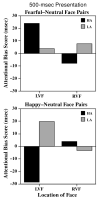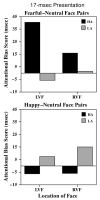Processing emotional facial expressions: the role of anxiety and awareness
- PMID: 12452584
- PMCID: PMC3605771
- DOI: 10.3758/cabn.2.1.52
Processing emotional facial expressions: the role of anxiety and awareness
Abstract
In this paper, the role of self-reported anxiety and degree of conscious awareness as determinants of the selective processing of affective facial expressions is investigated. In two experiments, an attentional bias toward fearful facial expressions was observed, although this bias was apparent only for those reporting high levels of trait anxiety and only when the emotional face was presented in the left visual field. This pattern was especially strong when the participants were unaware of the presence of the facial stimuli. In Experiment 3, a patient with right-hemisphere brain damage and visual extinction was presented with photographs of faces and fruits on unilateral and bilateral trials. On bilateral trials, it was found that faces produced less extinction than did fruits. Moreover, faces portraying a fearful or a happy expression tended to produce less extinction than did neutral expressions. This suggests that emotional facial expressions may be less dependent on attention to achieve awareness. The implications of these results for understanding the relations between attention, emotion, and anxiety are discussed.
Figures



References
-
- Armony J, LeDoux JE. How danger is encoded: Toward a systems, cellular, and computational understanding of cognitive-emotional interactions in fear. In: Gazzaniga MS, editor. The new cognitive neurosciences. 2nd ed. MIT Press; Cambridge, MA: 2000. pp. 1067–1079.
-
- Bradley BP, Mogg K, Falla SJ, Hamilton LR. Attentional bias for threatening facial expressions in anxiety: Manipulation of stimulus duration. Cognition & Emotion. 1998;6:737–753.
-
- Bradley BP, Mogg K, Millar NH. Covert and overt orienting of attention to emotional faces in anxiety. Cognition & Emotion. 2000;14:789–808.
-
- Byrne A, Eysenck MW. Trait anxiety, anxious mood, and threat detection. Cognition & Emotion. 1995;9:549–562.
-
- Cheesman J, Merikle PM. Distinguishing conscious from unconscious perceptual processes. Canadian Journal of Psychology. 1986;40:343–367. - PubMed
Publication types
MeSH terms
Grants and funding
LinkOut - more resources
Full Text Sources
Medical
